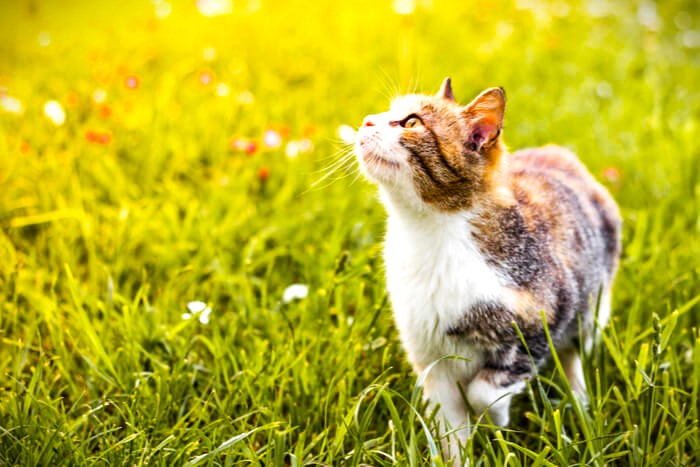Is your indoor cat hankering to venture outdoors? It’s common for cat parents to experience some guilt about their cat’s constant indoor confinement, particularly if they express interest in exploring the outdoors. Many cats ‘ask’ to go outside, but they have no idea what’s in store for them there. While many pet parents can create a stimulating indoor environment for their cats with enrichment activities, lots of windows, cat-friendly plants, and some outdoor solutions we discuss below, it can be difficult to replicate the exact outdoor experience.
Nonetheless, you should always put your cat’s safety first, and letting your indoor cat go outside carries some serious risks. These are explained below, along with some useful advice for allowing your cat to safely explore the outdoors.

Advantages of Cats Indoors vs. Outside
Potential adopters are frequently asked by cat rescues to commit to keeping their cats indoors, and many vets also advise against it. This is supported by some very sound logic, especially in light of your cat’s wellbeing and security.
According to UC Davis Veterinary Medicine, indoor cats typically live about 10 to 15 years longer than outdoor cats—roughly twice as long. This is due to the fact that cats may encounter numerous outdoor risks, such as parasites, illnesses, vehicles, coyote predators, poisons, and other creatures.
You can protect your cat from these possible hazards by keeping them inside. Additionally, you spend a great deal more time with your cat, giving you the chance to notice any health problems early on. Keeping your cat indoors also reduces the chance that they will become lost or be picked up by animal control or by other people. Since even well-fed cats have a propensity to hunt birds and other small prey and can seriously negatively impact wildlife in your surrounding area, you also contribute to the protection of natural wildlife. It’s estimated that domestic cats kill over 2 billion birds a year in the US alone.
If you still need more proof that it’s best to keep your cat indoors, just think about how many more risks there are when allowing a cat to roam freely outside than there are advantages:
Advantages
- More activity and room to run
- greater availability of sunshine and fresh air
- novel and intriguing scents
Cons
- More prone to disease, harm, or death from toxins, parasites, cars, and other sources
- possibly deadly to outdoor wildlife
How to Allow Your Cat to Go Outside Safely
If a cat has access to a sunny windowsill, they can still reap many of the benefits of being outside even if they spend their entire life indoors. For an extra-cozy spot for your cat to sit and watch the birds and squirrels, place a hammock bed or a cat tree in front of their favorite window. Additionally, open the window to let them enjoy the breeze when the weather permits it (and if you have a screen installed).
Make sure to take precautions if you still want your cat to go outside. This comprises:
- Getting your cat to accompany you on a leash and harness when you go outside
building or buying a mesh cat enclosure, or “catio” (a lot of spacious, safe outdoor cat enclosures are available online). - ensuring that your cat receives the recommended annual screenings for heartworm and flea/tick infections, and informing your veterinarian that your cat spends time outside.
- Make sure your cat is always under your watch when they are outside, and never leave them alone.
- Between keeping your cat inside all the time and exposing them to the hazards of life as an outside cat, there is undoubtedly a happy medium. Your cat might even be able to be trained to walk on a leash and go on other adventures, depending on their temperament. Alternatively, they might just be a nice friend who you can sit in the backyard with occasionally to enjoy the sunshine.
In either case, pay close attention to your cat’s cues and prioritize safety. While some cats may be content to walk outside on a leash and harness or explore a small patch of grass under your close supervision, many cats are content to live entirely indoors. Apply common sense, and when in doubt, stay indoors with your cat to err on the side of safety.




